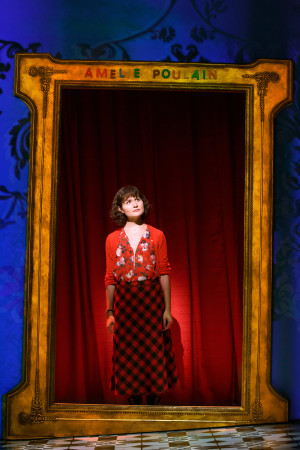Do you remember that odd 2001 French film “Amelie” with the quirky characters, lack of plot, memorable music, Parisian setting, and awkwardly bright colors? If you do, maybe you’ll like the new “Amelie” musical, directed by Pam MacKinnon and opening at the Walter Kerr on April 3rd. Maybe. If you don’t remember or never saw the bizarre, childlike film the musical is based on, there is probably little chance you’ll enjoy this musical.
Assuming you have never heard of the film (which most of us haven’t) here’s a quick synopsis: an imaginative woman with hypochondriac and distant parents grows up and decides she wants to help strangers but is too shy to talk to them. Sound odd? Well, it is. Both the original film and the new musical have basically no plot events or structure. Most of the characters appear briefly and never return. Almost no one other than Amelie has a solo song. Her ex-circus performer boss, hypochondriac coworker, and brittle-bone diseased Renoir-painting elderly neighbor (you can’t make this stuff up, where else could you get characters so unrealistic and annoyingly “quirky”) are the only recurring roles other than her love interest, Nino. It’s hard to even provide accolades to any of the actors, because their characters made no sense, were only briefly in the show, had almost no characterization, and were given no chance to show off their vocal talents.
The same cannot be said of the lead, Phillipa Soo, who was certainly given the stage time and songs to prove that she is a talented actress. However, she deserves a much better show that “Amelie.” After wowing audiences as Eliza in “Hamilton,” this is certainly a disappointment. The lack of wow-factor from Soo here will be dangerous for the show because the only thing drawing in audiences to this odd musical is her name on the marquis.
Maybe Adam Chandler-Berat as Nino, her love interest, and Tony Sheldon as Dufayel, the elderly neighbor, are worthy of some praise. However, to be to the rest of the cast, it is worth mentioning that there are the only actors other than Soo that were given songs, so it is logical that everyone else faded into the background.

That aforementioned background they faded into, however, was far from monotone or boring. The set and costumes by David Zinn and lighting by Jane Cox and Mark Barton are best described as distracting. The movie was famous for its bright aesthetic of single-color outfits, which translated on the stage felt childish and crayon-inspired. The lighting was equally and awkwardly bright, emphasizes separate monotone palettes for each scene; often the lighting felt sloppy, full of too small follow spots that were always a second behind and scenes of actors with their faces in the dark. The set was made of walls of wardrobes, drawers, and cabinets, all that made several false prosceniums that were just ever-so titled to make the audience nauseated. This made the stage feel like a cluttered interior–a complete antithesis of the cobblestone streets of Montmartre, Paris that were so beautiful in the film.
One of the strangest parts of “Amelie” was the interplay of tone, style, and genre. It’s hard to know exactly what “Amelie” is. In one scene, there was a fish puppet on a male actor’s head. In another, there was a wall of sex toys and a neon sign of a naked woman. In yet another, there was a dancing gnome. Elton John made an appearance. So did a carousel. At times it feels a show for children; at other times it feels like a poorly-conceived art piece that was trying to be indie and quirky.
But before anyone has the chance to decide or conclude what kind of piece of theater they are seeing or why it’s just a bit off, the show is over. “Amelie” runs about one hour and forty minutes, no intermission. Quite literally, it is a one-act musical. But unlike other no-intermission shows, like “Fun Home,” when this show ends, you think there should be an intermission. In the finale of the show, like the rest of the show, basically, nothing happens. Upon realizing the show is over, a wave of confusion comes on: what did I watch? What just happened? Where was the plot? Can it really be over? Somehow Craig Lucas (book), Daniel Messe (music and lyrics), and Nathan Tysen (lyrics) managed to take a two hour and ten-minute movie, adapt it to a musical and add songs, and somehow end up with a one-act musical thirty minutes shorter than the movie.
“Amelie” isn’t awful. Phillipa Soo is actually quite good, though she has certainly done better. There isn’t anything necessarily wrong with “Amelie,” but there isn’t anything necessarily right about it either.






